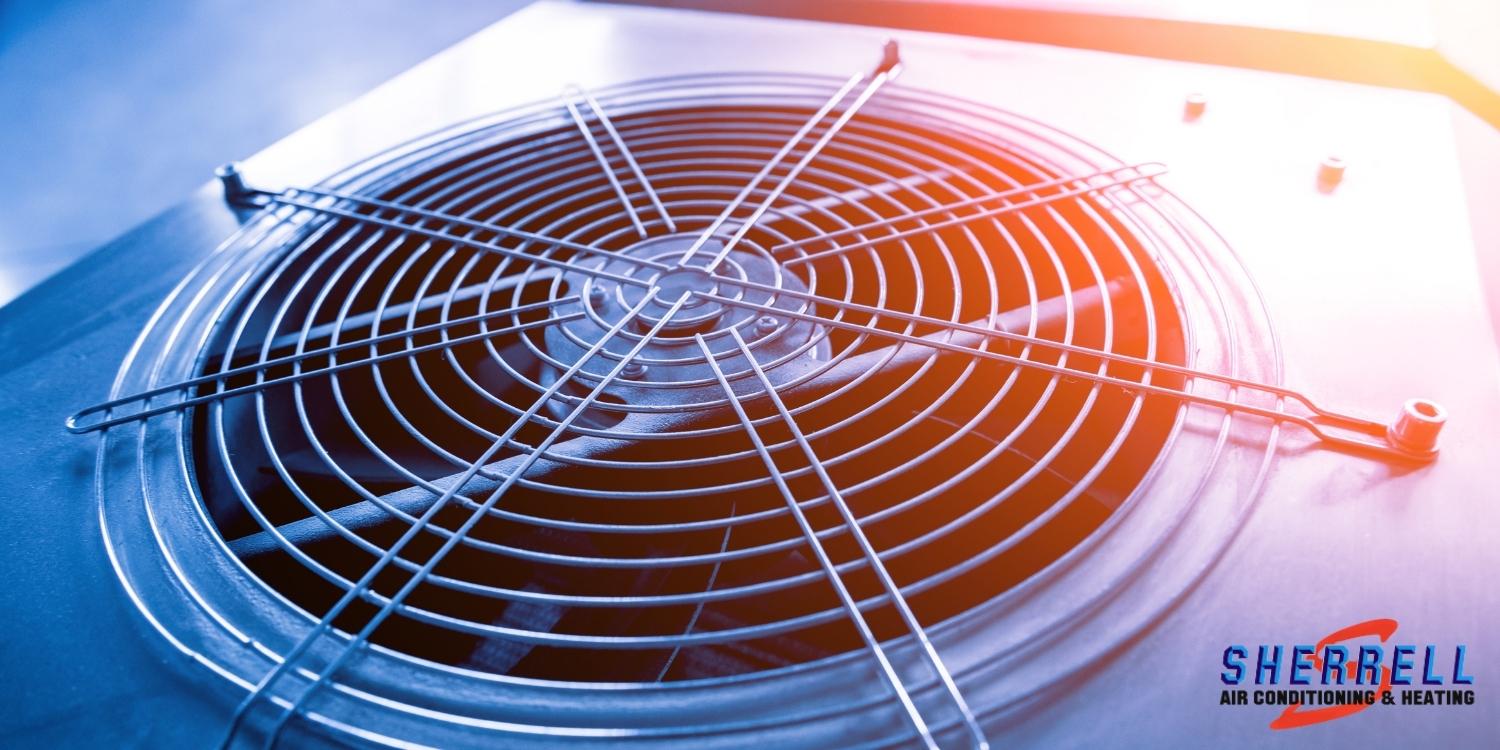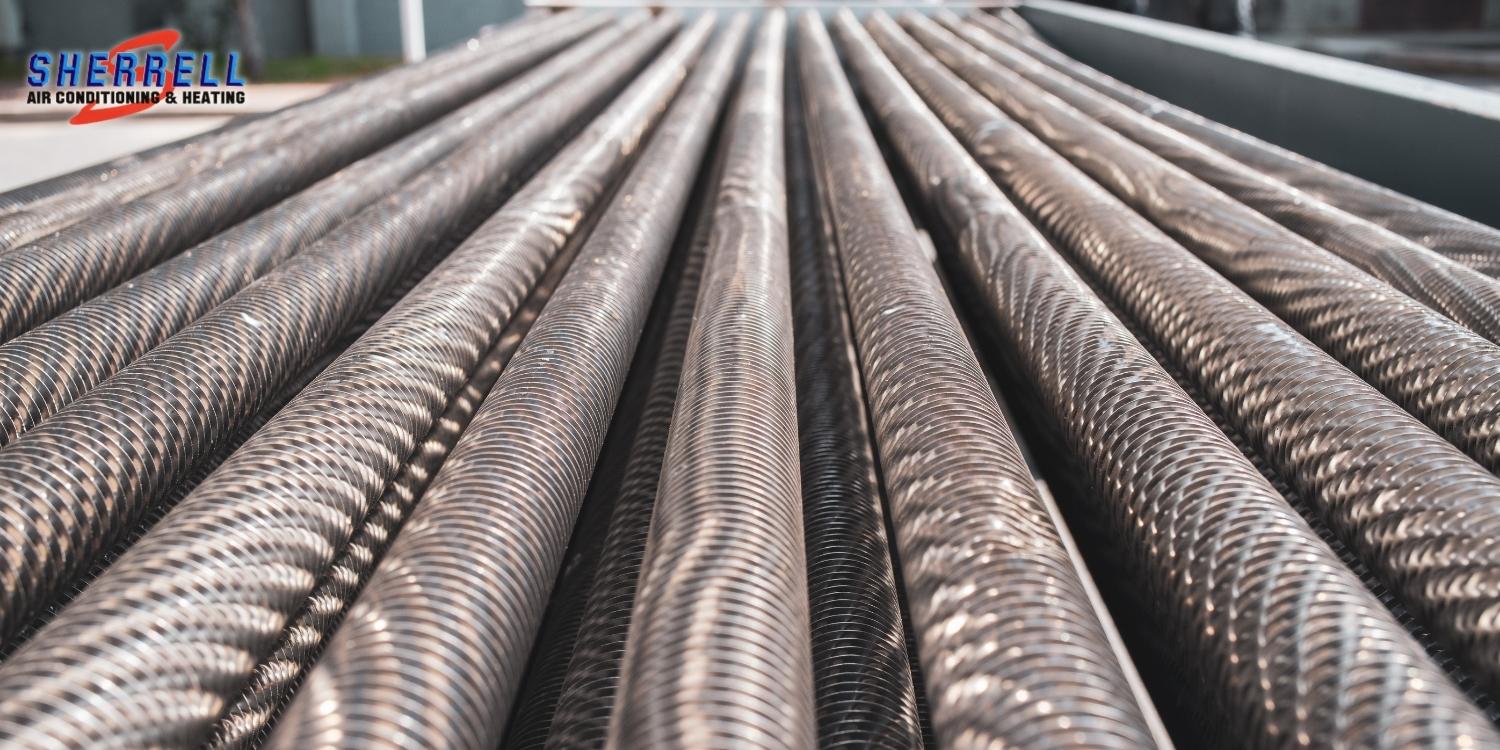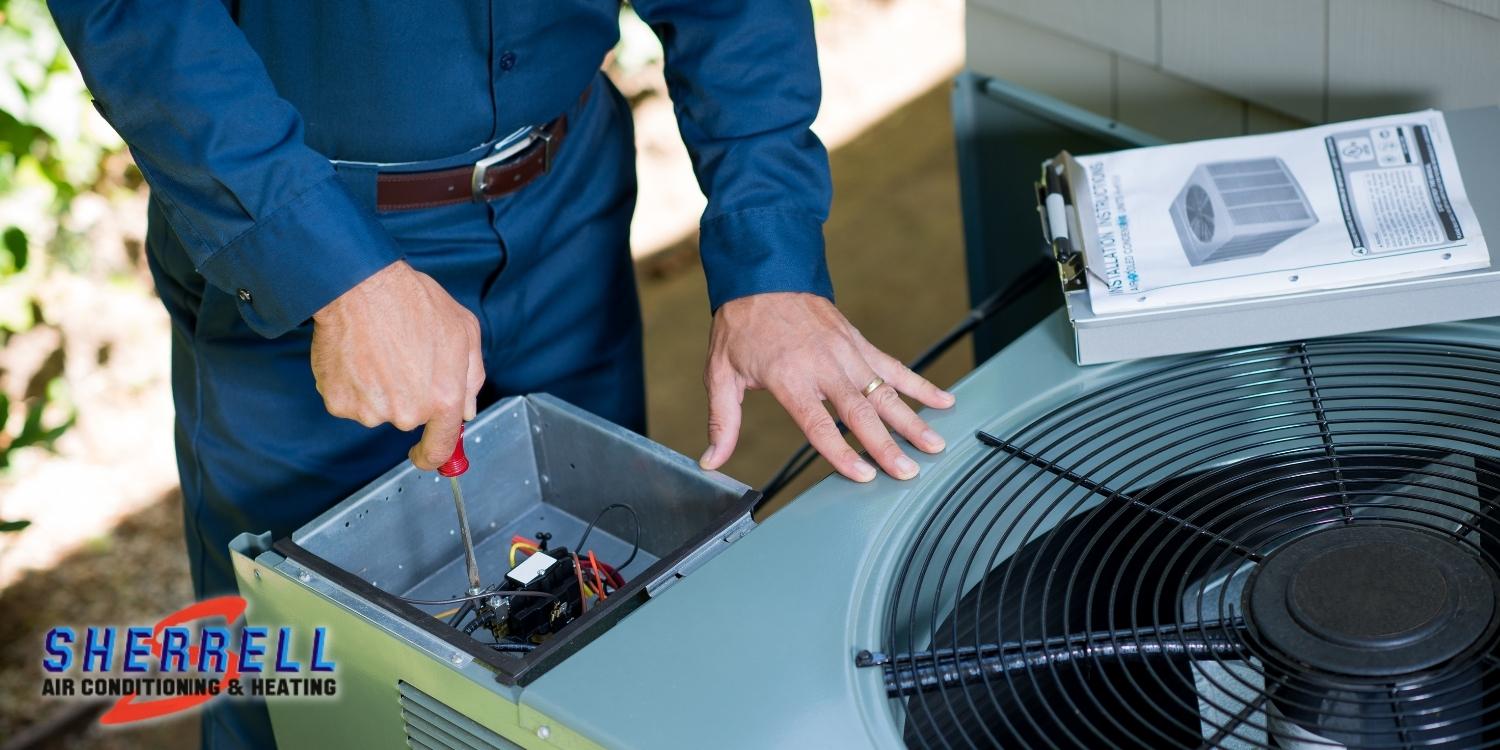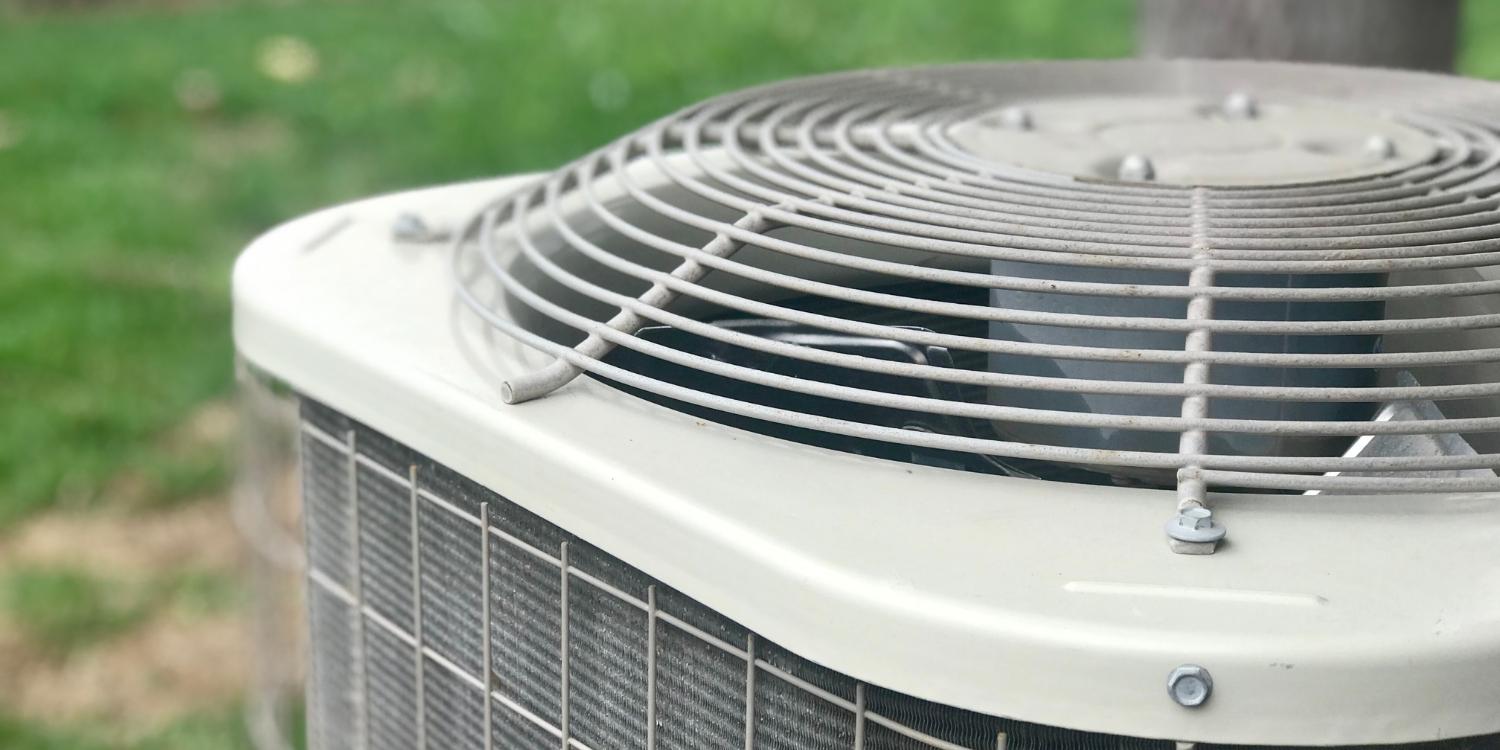As the scorching Texan summer sun beats down, your air conditioner becomes your best ally in maintaining indoor comfort. However, have you ever wondered about the intricate machinery working diligently behind the scenes to keep your home cool and comfortable?
In this blog, our Sherrell Air cooling experts will explain the parts of an air conditioner, breaking down each crucial element that plays a pivotal role in ensuring your space remains refreshingly cool when the Dallas heat becomes relentless. Whether you’re a seasoned HVAC enthusiast or just looking to understand your cooling system a little better, this comprehensive exploration of air conditioner components will leave you with a newfound appreciation for the technology that keeps your home comfortable year-round.
Whether you need AC repairs, AC replacement, or just an AC tune-up, you can count on the Dallas HVAC technicians at Sherrell Air Conditioning and Heating to get your home cooling off in no time.
Air Conditioner Parts and Functions
Understanding the various parts and functions of air conditioners requires unraveling the inner workings of this intricate, complex piece of machinery. Each component works together to transform hot air into a cool, refreshing breeze. From the compressor to the evaporator and beyond, we’ll explore how these components work together seamlessly to keep your indoor environment cool and comfortable.

Condenser Unit (Outdoor Unit)
The condenser unit, or outdoor unit, is responsible for releasing the hot air that has been absorbed from inside a building. Located outdoors, the condenser unit works by compressing a refrigerant gas. This compression causes the gas to become hot, and it is then pumped through coils and fins within the unit. As the hot gas flows through these coils, it releases the heat gathered from the indoor space into the outdoor air. This process transforms the refrigerant into a high-pressure, high-temperature liquid.
The outdoor unit is equipped with a fan that helps remove the heat more effectively, allowing the refrigerant to return to the indoor unit as a cool, low-pressure gas, ready to absorb more heat and continue the cooling cycle.
Evaporator Unit (Indoor Unit)
The primary function of the evaporator unit, or indoor unit, is to facilitate the evaporation of a refrigerant, which absorbs heat from the indoor air. It consists of a coil system with fins, and as warm indoor air passes over these coils, the refrigerant inside them evaporates. This phase change from liquid to gas absorbs heat from the surrounding air, effectively cooling it.
Once the air is cooled, a blower fan inside the evaporator unit circulates it through the ductwork, distributing the cool air throughout the building. As the process continues, the refrigerant, now in a gaseous state, is sent to the outdoor condenser unit to release the heat it has absorbed.
Condenser Coils
A condenser coil is typically made of copper or aluminum tubes with fins that help eliminate heat more effectively. The hot, high-pressure refrigerant gas from the compressor flows through these coils. As it circulates through the coils, the refrigerant releases the heat it has collected from inside the building into the surrounding outdoor air.
During this process, the refrigerant undergoes a phase change, transitioning from a gas to a high-pressure, high-temperature liquid. The condenser coils’ design and the fan located near them aid in efficiently transferring the heat away from the refrigerant, allowing it to return to the indoor unit as a cool, low-pressure gas to continue the cooling cycle.

Evaporator Coils
Evaporator coils are typically found in the air handler and are essential to the air conditioning process. The evaporator coils cool and dehumidify the indoor air. Typically made of copper or aluminum tubes with fins to enhance heat exchange, evaporator coils are designed to facilitate the evaporation of a refrigerant.
When a blower fan blows warm air over these coils, the refrigerant absorbs heat. This causes the air to cool down and lose moisture, resulting in a more comfortable and less humid indoor environment. As the refrigerant in the evaporator coil changes from a liquid to a low-pressure gas, it becomes cold. It is then circulated to the outdoor condenser unit to release the absorbed heat. This cycle continues to maintain the desired indoor temperature.
Compressor
The compressor acts as the “heart” of the air conditioning unit, actively maintaining the circulation and pressure of the refrigerant, which is essential for the system to function efficiently and effectively in providing cooled air inside. This part is also responsible for the air conditioner’s energy consumption and is the most expensive piece of the AC unit.
When the refrigerant enters the compressor, it is in a low-pressure, low-temperature gaseous state. The compressor’s purpose is to compress this gas, causing it to become high-pressure and high-temperature.
This compression process is essential because it allows the refrigerant to release heat more efficiently when it flows through the condenser coils in the outdoor unit. As the hot, high-pressure gas travels through these coils, it gives off the heat absorbed from the indoor space, transforming into a high-pressure liquid.
The now-liquid refrigerant is sent to the indoor evaporator coils to continue the cooling cycle. This process of compression and expansion of the refrigerant is at the core of how an air conditioner extracts heat from inside a building and releases it outdoors, ultimately providing the cooling effect we know, love, and in Texas, need.
Refrigerant Lines
Refrigerant lines facilitate the flow of refrigerant between the indoor and outdoor units. These lines connect the indoor evaporator unit to the outdoor condenser unit. They create a closed-loop system through which the refrigerant cycles continuously. The refrigerant lines are typically made of copper or sometimes aluminum and carry the refrigerant in both its gas and liquid states.
Refrigerant lines must be properly sized, insulated, and sealed to ensure the efficient and effective operation of the air conditioning system. They are important in transferring heat between indoor and outdoor units, enabling the air conditioner to cool and dehumidify indoor spaces effectively.
Expansion Valve
Expansion valves control the refrigerant flow through the system, regulating its pressure and temperature as it moves through various stages of the cooling cycle. Their precise regulation of the refrigerant’s expansion helps achieve efficient cooling and dehumidification, making them a fundamental component in maintaining indoor comfort.
Blower Fan
The blower fan is located within the indoor unit. It circulates conditioned air throughout a building, whether it’s warm air from the furnace in the winter or cool air from the air conditioner in the summer. By distributing air through the ductwork and into various rooms, the blower fan ensures consistent and comfortable indoor temperatures while assisting in air filtration and ventilation.

Thermostat
Think of the thermostat as the brain of your heating and cooling system, serving as the control center for maintaining your desired indoor temperature. It allows you to set and adjust the temperature in your home, ensuring that your air conditioner activates when needed to keep you comfortable.
Modern thermostats often come with programmable and smart features, providing convenience, energy savings, and the ability to control your HVAC system remotely through mobile devices.
Air Filter
Air filters improve indoor air quality by capturing airborne particles like dust, pollen, pet dander, and allergens as air circulates. These filters help maintain a healthier and cleaner environment by trapping contaminants and preventing them from recirculating in your home. Regularly changing or cleaning your air filter is essential for optimal system performance and to ensure that the air you breathe is as clean and pollutant-free as possible.
Ductwork
Ductwork is the hidden network of channels, usually made of metal or flexible material, that distributes conditioned air throughout your home. The air ducts help maintain consistent indoor comfort by delivering warm or cool air to various rooms. Properly designed and maintained ductwork ensures efficient airflow, minimizes energy loss, and improves the air conditioner’s overall effectiveness.
Condensate Drain Pan
The condensate drain pan is found underneath the indoor evaporator unit. Its primary function is to collect and safely remove the condensation that forms on the evaporator coils as warm, humid indoor air is cooled. This prevents water from pooling and potentially causing damage to your air conditioner or the surrounding area, ensuring that your cooling system operates efficiently and without leaks.
Drain Line
The drain line works in tandem with the condensate drain pan. It provides a pathway for the collected condensate to flow away from the indoor unit and out of your home. Proper maintenance of the drain line is essential to prevent clogs or blockages that can lead to water damage and potential mold growth.
Capacitor
The capacitor is an electrical component found in the outdoor unit. It’s responsible for starting and running the system’s motors, particularly the compressor and fan motors. Capacitors store and release electrical energy when needed, providing the necessary electrical boost to start these motors and maintain their operation while ensuring the efficient functioning of the entire air conditioning unit.
Relay and Contactors
Relays and contactors serve the important function of controlling the flow of electrical current to different system parts, such as the compressor, fan motors, and other high-power components.
Relays are typically used for low-voltage applications, acting as switches that allow a small electrical signal to control a larger electrical load. In HVAC systems, relays are often used to control the activation of components like the blower fan or auxiliary heaters.
Contactors, on the other hand, are designed for high-voltage, high-amperage applications. They are commonly used to control the flow of electricity to critical components like the compressor and condenser fan motor in an HVAC unit. When the thermostat calls for cooling, the contactor engages, allowing electrical current to flow through these components, which initiates the cooling cycle.

The Importance of Maintaining the Parts of Your Air Conditioning System
Regular maintenance of the various components of air conditioners is essential for ensuring their efficiency, longevity, and overall indoor comfort. Neglecting maintenance can reduce cooling capacity and result in higher energy bills and even costly breakdowns. By keeping the parts of your AC system in good working order through routine inspections, cleaning, and necessary repairs, you can enjoy consistent and efficient cooling while potentially extending the lifespan of your system.
At Sherrell Air Conditioning and Heating, our customers can join our preventative maintenance program, the Cool Club. Members enjoy special discounts, competitive pricing, and two maintenance checks each year. Routine maintenance on your air conditioner components can ensure longevity and help avoid emergencies.

For All Your Dallas Air Conditioning Needs, Call the HVAC Experts at Sherrell Air Today!
Now that you know the parts of an air conditioner and how they work, you can understand why it’s important that each component is properly maintained to ensure maximum efficiency. When one part of the air conditioner isn’t working effectively, it can disrupt the entire cooling process.
To schedule a maintenance appointment to ensure your HVAC unit is properly working, contact the Dallas heating and cooling experts at Sherrell Air today by calling (972) 216-1961 or completing our online contact form.









